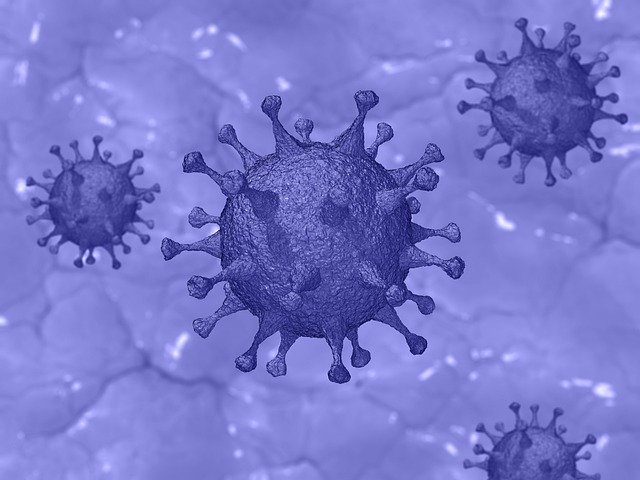
Här beskrivs hur det kommer sig att personer med ohälsa, och särskilt metabolt syndrom, lättare insjuknar i allvarlig Covid-19.
Jeffrey Bland, känd som grundaren av funktionsmedicin, har skrivit en lång intressant artikel om Covid-19 (se länk nedan). Jag kommer särskilt att lyfta ut en intressant mekanism han tar upp i artikeln, men läs gärna hela via länken.
ACE2 som jag skrivit om tidigare (https://4health.se/?s=ACE2) är ju det nya coronavirusets inkörsport i cellerna. Det visar sig att viruset lättare binder till ACE2 i närvaro av inflammation.

CoV-SARS-2-viruset har proteiner på sin yta som ser ut som taggar. Det är dessa som gör att det kan binda in till ACE-2-receptorer, och även dessa som skiljer det nya coronaviruset från andra Coronavirus.
Taggarna på viruset har hög affinitet till ett enzym som kallas furin (high affinity furin binding sites). Furin är ett enzym i blodet som ska aktivera särskilda proteiner.
Det nya coronaviruset kan kidnappa furin, vilket tillåter det att binda till ACE2-receptorerna enklare och bättre, och underlättar för viruset att ta sig in i våra celler.
Furinnivåerna i vårt blod spelar alltså stor roll för hur lätt vi infekteras, och hur mycket vi insjuknar.
Regleringen av furin påverkas bl.a. av immunsystemet och inflammation. Vid inflammation och höga nivåer av triglycerider i blodet så är furin mer känsligt för att kidnappas av viruset (notera att lågkolhydratkost vanligen ger mycket låga nivåer av triglycerider, mer i avsnitt 139 och 140 av podcasten). Detta kan troligen bidra till det som kallas “comorbidity”, dvs att personer med inflammatoriska sjukdomstillstånd, i synnerhet metabola syndrom (högt blodtryck, diabetes, hjärt- och kärlsjukdom, övervikt osv), har ökad dödlighet i Covid-19.
Man har sett i studier att personer med metabolt syndrom har avvikande nivåer av furin. En studie (som bl.a. utförts av forskare i Lund) visade att personer med metabola syndrom och diabetes har förhöjda nivåer av furin i blodet. Och man har i andra studier sett att de gener som styr furinproduktion påverkas av metabola syndrom. Man vet också att personer med inflammatoriska autoimmuna sjukdomar har förhöjda nivåer av furin.
Furin verkar alltså vara en länk mellan metabolt syndrom, inflammation och Covid-19-komplikationer.
Saxat ur artikeln
Först bakgrund om Covid-19 och metabolt syndrom:
Why do some people fare so poorly while others have only mild symptoms? The answer may be tied to the functional status of an individual’s immune system.
how comorbidities (preexisting health conditions) might increase the risk for COVID-19 complications. The researchers noted that older age, hypertension, obesity, and diabetes were all associated with increased disease severity.
Certain chronic conditions, including the comorbidities mentioned above, result in altered immune system function, which can include unhealthy forms of inflammation.
As it turns out, there is a condition called metabolic syndrome which is characterized by altered immune function. In fact, it overlaps with the comorbidities that contribute to COVID-19 severity, and has been steadily rising in frequency over the last several decades. What happens when the world’s most prevalent non-communicable health condition and a highly infectious viral disease collide? We find ourselves in our new reality: a COVID-19 pandemic within a pandemic of metabolic syndrome.
I believe these comorbidities result from the complex interaction of individual genetics, lifestyle, environment, diet, and the social determinants of disease.
all of the comorbidities linked to both metabolic syndrome and COVID-19 severity are associated with altered immune function and a chronic state of inflammation.[13] “Inflammaging” is a term that has come to be used as a descriptor for chronic inflammation related to aging or chronic non-communicable conditions such as hypertension, insulin resistance, and obesity.
Technically, metabolic syndrome is not a disease. It is probably better described as a state of lowered resilience to disease, as is evidenced by the number of associated comorbidities. People with metabolic syndrome are at increased risk to both non-communicable and infectious diseases such as COVID-19.
Och så om den fysiologiska mekanismen:
COVID-19 is a new virus within the coronavirus family. As we all know now, it has a very high infection rate. Additionally, COVID-19 has some unusual infectivity features: it can be transmitted by asymptomatic individuals, plus the severity and clinical manifestations of the infection can vary widely (from mild to life-threatening). Seemingly, all body systems can be impacted by a COVID-19 infection; serious cases of respiratory, cardiovascular, immunological, kidney and liver, gastrointestinal, and neurological crises have all been reported.[21] In the organ systems affected by COVID-19, cells have been found to express the angiotensin-converting enzyme 2 (ACE2) receptor. The ACE2 receptor is thought to represent a target for the virus which allows it to bind to and enter our cells.[22] Recent studies show that the virus binds to the ACE2 receptor more easily in the presence of inflammation.[23]
The COVID-19 virus has spike-like proteins on its surface. These give the virus the unique ability to bind tightly to the ACE2 receptors. The spike-like proteins are also what differentiate the COVID-19 virus from other coronaviruses. These spikes have what are called high affinity furin binding sites (furin is an enzyme in human blood that activates specific proteins).[24] Researchers believe a slight change in the genetic architecture of the virus resulted in a modification at the furin binding site in the spike proteins. This is what makes COVID-19 such a formidable foe. How? It enables the virus to hijack furin, which allows it to attach to the ACE2 receptors on tissues more readily and facilitate penetration into cells. Given that so many tissues express the ACE2 receptor, this mutation and sequence of events makes COVID-19 uniquely more infective than other coronaviruses.[25]
Regulation of furin levels in the blood is influenced, in part, by the immune system and inflammation. When cholesterol in the blood is elevated, furin is more vulnerable to being hijacked by the virus, and there is a greater opportunity for COVID-19 to convert to its more infective form. It is speculated that this can contribute to the comorbidity-related priming of COVID-19 in people with elevated cholesterol who are at risk to cardiovascular problems.[26] The ability of this virus to impact furin and increase infectivity is unique to COVID-19 (SARS-COV-2); it does not occur (to the same extent) with other coronaviruses, including SARS-COV-1.
Furin belongs to a family of nine proteins that are called proprotein convertases (PCSKs). The function of these proteins is to regulate various biochemical processes, both in times of good health and when a disease state is present. Furin is produced by a number of different cell types, including some within immune cells.[27] In people who have comorbidities that are associated with metabolic syndrome (hypertension, obesity, elevated triglycerides, impaired insulin sensitivity, and inflammation), furin levels have been found to be abnormal.[28],[29] Interestingly, David Harrison, MD, who leads a research team at Vanderbilt University School of Medicine, published work in 2015 indicating that hypertension is related to inflammation derived from an activated immune system.[30]
In 2018, researchers at the Department of Clinical Sciences at Lund University in Sweden and the School of Pharmacology at Helsinki University in Finland collaboratively reported the results of a study involving 4678 individuals with metabolic syndrome and diabetes that revealed elevated levels of furin in the blood.[31] Prior to that, a group representing several clinical and academic institutions in Japan had reported that certain variations in the genes that control furin production were related to metabolic syndrome.[32] This work suggests that the influence of furin on the comorbidities associated with COVID-19 may have a genetic connection. Finally, it’s well established that furin levels are elevated in people with inflammatory autoimmune disorders.[33] In sum, this research shows furin may be a key link between metabolic syndrome, inflammation, and COVID-19 complications.
Summerat:
Let’s now draw a straight line between the non-infectious pandemic of metabolic syndrome pandemic and the infectious pandemic of COVID-19. Metabolic syndrome dramatically increases our risk of developing comorbidities like hypertension and diabetes. These in turn predispose us to contracting COVID-19 and for developing more severe systems after infection. This is likely due to the chronic inflammatory state (altered immunity) associated with metabolic syndrome. Furthermore, the comorbidities associated with metabolic syndrome may compromise our immune function through increased levels of furin in the blood. Let’s put this together. When an individual with metabolic syndrome is exposed to COVID-19, the virus gets the benefit of a compromised immune system and extra furin to facilitate binding to our cells. This is a mechanistic explanation of the situation that the world now finds itself in: a pandemic (COVID-19) within a pandemic (metabolic syndrome).
Om lösningen:
Food as medicine? A recent article suggests that it’s a valid concept to consider for the prevention of coronavirus disease.[38]Emerging evidence even shows that dietary intervention could potentially reduce the probability of infection with COVID-19 or the severity of symptoms in infected individuals.[39] Recently, a multinational research consortium published work indicating that a diet associated with lowering the incidence of metabolic syndrome both improves immune system function and reduces inflammation, which — as already noted — are important considerations in minimizing the severity of COVID-19.[40]
Vegetables and fruits contain a class of nutrients called phytochemicals that play important dietary roles in reducing the comorbidities associated with metabolic syndrome.[41] Certain phytochemicals, such as the flavonoids quercetin and luteolin, have been found to bind to the ACE2 receptor on COVID-19, which can potentially help to protect against infection.[42],[43] A recent study evaluated how quercetin and vitamin D may contribute to the mitigation of COVID-19 through their impact on immune system function and the reduction of chronic inflammation.[44] It is clear that improvement in the lifestyle, environmental, and dietary factors associated with the comorbidities that are linked to both metabolic syndrome and COVID-19 can have a positive impact on enhancing immunity.[45] Studies have shown that improved physical fitness, reduction in obesity, and increased quality of sleep can all positively influence immunity and reduce the severity of viral infections like COVID-19.[46],[47],[48]
In a sense, COVID-19 represents an alarm bell — “a tocsin to our aging and unfit society,”
Mer via https://4health.se/?s=corona
https://medium.com/@jeffreyblandphd/covid-19-a-pandemic-within-a-pandemic

Lämna ett svar